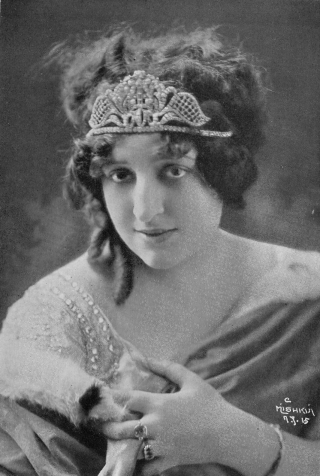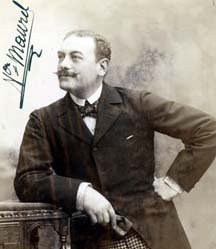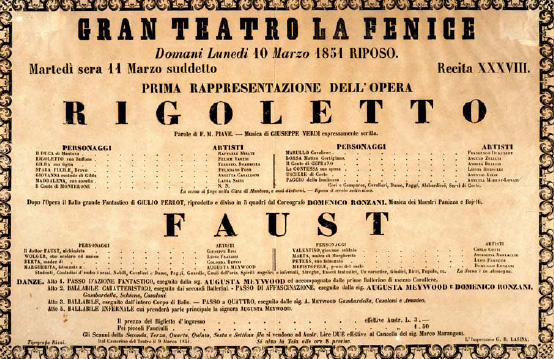|
Lirico-spinto
Spinto (from Italian, "pushed") is a vocal term used to characterize a soprano or tenor voice of a weight between lyric and dramatic that is capable of handling large musical climaxes in opera at moderate intervals. (Sometimes the terms ' or ' are used to denote this category of voice.) The spinto voice type is recognisable by its tonal "slice" or ''squillo''. This enables the singer to cut through the wall of sound produced by a full Romantic orchestra in a wide variety of roles, excluding only the most taxing ones written by the likes of Richard Wagner (such as ''Brünhilde'', ''Isolde'', ''Tristan'' and ''Siegfried''), Giacomo Meyerbeer (''John of Leyden''), Verdi (''Otello''), Puccini (''Turandot'', ''Calaf'') and Richard Strauss (''Elektra''). * : a fundamentally lyric soprano with a fair amount of extra "pulp" in her tone and a distinct thrust in her vocal attack. As they possess both a lyric and a dramatic quality, spinto sopranos are suitable for a broad spectrum of rol ... [...More Info...] [...Related Items...] OR: [Wikipedia] [Google] [Baidu] |
Soprano
A soprano () is a type of classical female singing voice and has the highest vocal range of all voice types. The soprano's vocal range (using scientific pitch notation) is from approximately middle C (C4) = 261 Hz to "high A" (A5) = 880 Hz in choral music, or to "soprano C" (C6, two octaves above middle C) = 1046 Hz or higher in operatic music. In four-part chorale style harmony, the soprano takes the highest part, which often encompasses the melody. The soprano voice type is generally divided into the coloratura, soubrette, lyric, spinto, and dramatic soprano. Etymology The word "soprano" comes from the Italian word '' sopra'' (above, over, on top of),"Soprano" '' |
La Forza Del Destino
' (; ''The Power of Fate'', often translated ''The Force of Destiny'') is an Italian opera by Giuseppe Verdi. The libretto was written by Francesco Maria Piave based on a Spanish drama, ' (1835), by Ángel de Saavedra, 3rd Duke of Rivas, with a scene adapted from Friedrich Schiller's '' Wallensteins Lager'' (''Wallenstein's Camp''). It was first performed in the Bolshoi Kamenny Theatre of Saint Petersburg, Russia, on 29 November 1862 O.S. (N.S. 10 November). ' is frequently performed, and there have been a number of complete recordings. In addition, the overture (to the revised version of the opera) is part of the standard repertoire for orchestras, often played as the opening piece at concerts. Performance history Revisions After its premiere in Russia, ''La forza'' underwent some revisions and made its debut abroad with performances in Rome in 1863 under the title ''Don Alvaro''. Performances followed in Madrid (with the Duke of Rivas, the play's author, in attend ... [...More Info...] [...Related Items...] OR: [Wikipedia] [Google] [Baidu] |
Claudia Muzio
Claudia Muzio (7 February 1889 – 24 May 1936) was an Italian operatic soprano who enjoyed an international career during the early 20th century. Early years Claudina Emilia Maria Muzzio was born in Pavia, the daughter of Carlo Muzio, an operatic stage manager, whose engagements during her childhood took the family to opera houses around Italy as well as to Covent Garden in London and to the Metropolitan Opera in New York. Her mother was a choir singer, Giovanna Gavirati. Muzio arrived in London at the age of 2 and went to school there, becoming fluent in English, before returning to Italy at the age of 16 to study in Turin with Annetta Casaloni, a piano teacher and former operatic mezzo-soprano who had created the role of Maddalena in the world première of Verdi's ''Rigoletto''. Muzio then continued her vocal studies in Milan with Elettra Callery-Viviani. She also took the stage name of Claudia Muzio. Career Muzio made her operatic début in Arezzo (15 January 1910) in the t ... [...More Info...] [...Related Items...] OR: [Wikipedia] [Google] [Baidu] |
Vissi D'arte
"Vissi d'arte" is a soprano aria from act 2 of the opera ''Tosca'' by Giacomo Puccini. It is sung by Floria Tosca as she thinks of her fate, how the life of her beloved, Mario Cavaradossi, is at the mercy of Baron Scarpia and why God has seemingly abandoned her. The vocal range is E 4 to B5. Aria database site. Retrieved 17 July 2018 Libretto References External links * , televised performance by , 1959 * by *[...More Info...] [...Related Items...] OR: [Wikipedia] [Google] [Baidu] |
Fach
The German system (; literally "compartment" or "subject of study", here in the sense of "vocal specialization") is a method of classifying singers, primarily opera singers, according to the range, weight, and color of their voices. It is used worldwide, but primarily in Europe, especially in German-speaking countries and by repertory opera houses. The ' system is a convenience for singers and opera houses. It prevents singers from being asked to sing roles which they are incapable of performing. Opera companies keep lists of available singers by ' so that when they are casting roles for an upcoming production, they do not inadvertently contact performers who would be inappropriate for the part. Below is a list of ' (), their ranges as written on sheet music, and roles generally considered appropriate to each. When two names for the ' are given, the first is in more common use today. Where possible, an English and/or Italian equivalent of each ' is listed; however, not all ' hav ... [...More Info...] [...Related Items...] OR: [Wikipedia] [Google] [Baidu] |
Pagliacci
''Pagliacci'' (; literal translation, "Clowns") is an Italian opera in a prologue and two acts, with music and libretto by Ruggero Leoncavallo. The opera tells the tale of Canio, actor and leader of a commedia dell'arte theatrical company, who murders his wife Nedda and her lover Silvio on stage during a performance. ''Pagliacci'' premiered at the Teatro Dal Verme in Milan on 21 May 1892, conducted by Arturo Toscanini, with Adelina Stehle as Nedda, Fiorello Giraud as Canio, Victor Maurel as Tonio, and Mario Ancona as Silvio. Soon after its Italian premiere, the opera played in London (with Nellie Melba as Nedda) and in New York (on 15 June 1893, with Agostino Montegriffo as Canio). ''Pagliacci'' is the composer's only opera that is still widely performed. ''Pagliacci'' is often staged with ''Cavalleria rusticana'' by Pietro Mascagni, a double bill known colloquially as "Cav and Pag". Origin and disputes Leoncavallo was a little-known composer when Pietro Mascagni's ''Cavalleria ... [...More Info...] [...Related Items...] OR: [Wikipedia] [Google] [Baidu] |
Aida
''Aida'' (or ''Aïda'', ) is an opera in four acts by Giuseppe Verdi to an Italian libretto by Antonio Ghislanzoni. Set in the Old Kingdom of Egypt, it was commissioned by Cairo's Khedivial Opera House and had its première there on 24 December 1871, in a performance conducted by Giovanni Bottesini. Today the work holds a central place in the operatic canon, receiving performances every year around the world; at New York's Metropolitan Opera alone, ''Aida'' has been sung more than 1,100 times since 1886. Ghislanzoni's scheme follows a scenario often attributed to the French Egyptologist Auguste Mariette, but Verdi biographer Mary Jane Phillips-Matz argues that the source is actually Temistocle Solera. Elements of the opera's genesis and sources Isma'il Pasha, Khedive of Egypt, commissioned Verdi to write an opera to celebrate the opening of the Suez Canal, but Verdi declined. However, Auguste Mariette, a French Egyptologist, proposed to Khedive Pasha a plot for a celebratory ... [...More Info...] [...Related Items...] OR: [Wikipedia] [Google] [Baidu] |
Tosca
''Tosca'' is an opera in three acts by Giacomo Puccini to an Italian libretto by Luigi Illica and Giuseppe Giacosa. It premiered at the Teatro dell'Opera di Roma, Teatro Costanzi in Rome on 14 January 1900. The work, based on Victorien Sardou's 1887 French-language dramatic play, ''La Tosca'', is a melodramatic piece set in Rome in June 1800, with the Kingdom of Naples's control of Rome threatened by Napoleon's Campaigns of 1800 in the French Revolutionary Wars#Italy, invasion of Italy. It contains depictions of torture, murder, and suicide, as well as some of Puccini's best-known lyrical arias. Puccini saw Sardou's play when it was touring Italy in 1889 and, after some vacillation, obtained the rights to turn the work into an opera in 1895. Turning the wordy French play into a succinct Italian opera took four years, during which the composer repeatedly argued with his librettists and publisher. ''Tosca'' premiered at a time of unrest in Rome, and its first performance was delayed ... [...More Info...] [...Related Items...] OR: [Wikipedia] [Google] [Baidu] |
La Traviata
''La traviata'' (; ''The Fallen Woman'') is an opera in three acts by Giuseppe Verdi set to an Italian libretto by Francesco Maria Piave. It is based on ''La Dame aux camélias'' (1852), a play by Alexandre Dumas ''fils'' adapted from his own 1848 novel. The opera was originally titled ''Violetta'', after the main character. It was first performed on 6 March 1853 at La Fenice opera house in Venice. Piave and Verdi wanted to follow Dumas in giving the opera a contemporary setting, but the authorities at La Fenice insisted that it be set in the past, "c. 1700". It was not until the 1880s that the composer's and librettist's original wishes were carried out and " realistic" productions were staged. ''La traviata'' has become immensely popular and is among the most frequently performed of all operas. Composition history For Verdi, the years 1851 to 1853 were filled with operatic activity. First, he had agreed with the librettist Salvadore Cammarano on a subject for what would ... [...More Info...] [...Related Items...] OR: [Wikipedia] [Google] [Baidu] |
Rigoletto
''Rigoletto'' is an opera in three acts by Giuseppe Verdi. The Italian libretto was written by Francesco Maria Piave based on the 1832 play ''Le roi s'amuse'' by Victor Hugo. Despite serious initial problems with the Austrian censors who had control over northern Italian theatres at the time, the opera had a triumphant premiere at La Fenice in Venice on 11 March 1851. The work, Verdi's sixteenth in the genre, is widely considered to be the first of the operatic masterpieces of Verdi's middle-to-late career. Its tragic story revolves around the licentious Duchy of Mantua, Duke of Mantua, his hunch-backed court jester Rigoletto, and Rigoletto's daughter Gilda. The opera's original title, ''La maledizione'' (The Curse), refers to a curse placed on both the Duke and Rigoletto by a courtier whose daughter the Duke has seduced with Rigoletto's encouragement. The curse comes to fruition when Gilda falls in love with the Duke and sacrifices her life to save him from the assassin hired by ... [...More Info...] [...Related Items...] OR: [Wikipedia] [Google] [Baidu] |
Tenor
A tenor is a type of classical music, classical male singing human voice, voice whose vocal range lies between the countertenor and baritone voice types. It is the highest male chest voice type. The tenor's vocal range extends up to C5. The low extreme for tenors is widely defined to be B2, though some roles include an A2 (two As below middle C). At the highest extreme, some tenors can sing up to the second F above middle C (F5). The tenor voice type is generally divided into the ''leggero'' tenor, lyric tenor, spinto tenor, dramatic tenor, heldentenor, and tenor buffo or . History The name "tenor" derives from the Latin word ''wikt:teneo#Latin, tenere'', which means "to hold". As Fallows, Jander, Forbes, Steane, Harris and Waldman note in the "Tenor" article at ''Grove Music Online'': In polyphony between about 1250 and 1500, the [tenor was the] structurally fundamental (or 'holding') voice, vocal or instrumental; by the 15th century it came to signify the male voice that ... [...More Info...] [...Related Items...] OR: [Wikipedia] [Google] [Baidu] |






